|
FAQs about the Imperator Angel
Disease/Health 3
FAQs on Emperor Angel Health:
Emperor Disease 1, Emperor Disease 2,
Emperor Health 4,
Emperor Health 5, Emperor
Health ,
FAQs on Emperor Angel Health by Category:
Diagnosis, Environmental,
Nutritional, Pathogenic (see also: Angels and Butterflyfishes & Crypt), Social,
Trauma, Genetic,
Treatments
Related Articles: Imperator
Angels, Pomacanthus
Angels, Marine
Angelfishes,
Related FAQs:
Emperor
Angels 1, Emperor
Angels 2, Emperor Angels 3,
Emperor Angel ID, Emperor Behavior, Emperor Compatibility, Emperor Angel Selection, Emperor Angel Systems, Emperor Feeding, Marine Angelfishes In
General, Selection, Behavior,
Compatibility, Health, Feeding, Disease,
|
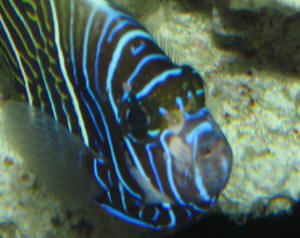
|
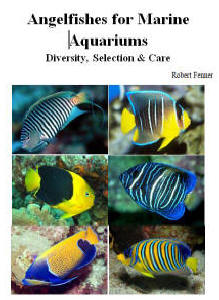 |
Angelfishes for Marine
Aquariums
Diversity, Selection & Care
New eBook on Amazon: Available
here
New Print Book on Create Space: Available
here
by Robert
(Bob) Fenner
|
Pomacanthus imperator with flukes and
mystery raised scale patch 5/13/09
I purchased my first large angelfish a couple weeks ago. He's a
beautiful juvenile Pomacanthus imperator. He's been eating like
a pig (I've been feeding him green Nori with added garlic,
Formula 1 and 2, all soaked in Zoe and VitaChem on a daily rotating
basis). Sadly, he's had some problems.
<<Christine here. Sorry to hear that he has issues, but it
seems you knew that before you purchased him. Risky, but I am
encouraged to see you really doing this thoughtfully. Feeding
regimen is superb.>>
He is housed alone in a 20 gallon quarantine tank with some PVC,
live rock rubble, and an established sponge filter. The water
parameters test as such:
Ammonia: 0
Nitrites: 0
Nitrates: 10
pH: 8.3
Specific Gravity: 1.024
Temp: 78 degrees F
<all good. You can drop the salinity a bit if you like to
encourage any uninvited "friends" living on him to drop
off.>
A couple days after his purchase, I noticed him scratching
specifically at one gill. Assuming he had ich (I could see a white
spot or two) I began treating him with 2.5mg/L concentration of
Cupramine.
<Test kit for Copper levels I hope?>
Two days later, I found him displaying telltale signs of flukes. He
was twitching his head from side to side, had discolored blotches
of skin, some of his fins were frayed, and he was breathing
rapidly. I thought for sure that I would lose him. Worried, I did a
5 minutes freshwater dip and flukes fell from his gills, his eyes,
and his body.
<Superb work>
I did a 100% water change to remove the Cupramine and stopped the
treatment altogether. I did some research and decided to treat the
quarantine tank with PraziPro at the recommended dose of 1 teaspoon
(5 ml) for the 20 gallons. So far, I have been treating him for 3
days. I saw him scratch once but overall, his breathing has calmed
down and he's behaving normally. After 5 days of treatment, I
plan to wait at least 3 days and treat with PraziPro again for
another 5-7 days at 2.5mg/L
<Good as well.>
Something else bothers me. In the store, I noticed a small area of
lifted scales. It looked like a simple physical injury to me and,
after being tempted by a cheap price tag, didn't seem like too
much of a concern. I've been keeping my eye on it and it seems
as though it's slowly changing, almost as if part of the area
is shedding off. I'm worried it's another external parasite
but this is my first fish problem besides ich. The spot itself is
lifted and white. I tried to take some photographs but the fish is
so active that it's difficult to get a great shot.
<Angelfish are terrible at posing unfortunately. The pic makes
it look like the area has some fleshy tan bits hanging off--is this
so, or an artifact of the picture?>
Do you have any ideas on possible treatments and/or a diagnosis?
Does his current PraziPro treatment seem realistic and
effective?
<Depends on what the problem is. Praziquantel is wonderful for
flukes, but not effective for much in the way of unicellular
parasites and bacteria, so it won't help you there. Two things:
one, if he had ich before, and you did a partial treatment, he
still has it in all likelihood. Before he joins your other animals
in the display I'd make sure he has had a full course of
treatment for ich, either hyposalinity or preferably the rest of
the Cupramine course. Second, that lesion could be anything based
on the photo--viral, bacterial, remnant damage... You can watch it
and see how it goes, or while he is in the middle of the
Praziquantel courses you could add some antibiotics to ensure no
bacterial infections. Favorites of mine include Kanamycin (hard to
find at your LFS but can be found at fishyfarmacy.com) or
Nitrofurazone (available locally). For me, expensive desirable
fish=high desire to try to treat instead of wait :) >
I know the special needs of this fish regarding diet and space. His
final destination will be in a 125 gallon with a 38 gallon sump.
Because he is my most expensive fish and I am cheap at heart, I am
determined to give him the best care possible!
<As I said so far your treatment and handling has been well
thought out and thorough. Do let us know how it goes.>
Thanks for your help!
-Alec
<pleasure, Christine> |
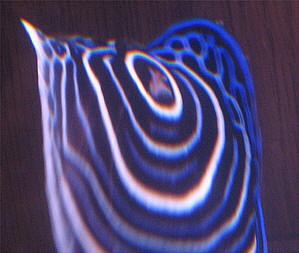 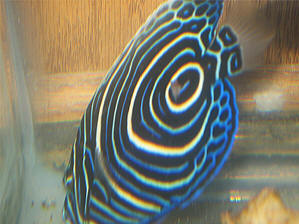 |
|
Re: Pomacanthus imperator with flukes and mystery
raised scale patch 5/28/2009
Thank you for the quick reply!
<Welcome>
Yes, I did test Cupramine while it was being administered. I
began testing with a API Copper test kit but found the levels to
be somewhat ambiguous. I purchased a Red Sea copper test kit to
double check my doses, finding the color chart to be more user
friendly. According to Seachem, the Red Sea kit is
appropriate.
I've always been wary of copper. I talked to Seachem support
to discuss the treatment of flukes with Cupramine.
<Mmm, not my choice of treatments... I'd look to
Anthelminthics... Levamisole would be the best... Prazi, others
secondary. Less toxic, more specific>
They told me that to be effective against flukes, the copper must
be at 0.4-0.5 mg/L. I've only ever treated at 0.25mg/L
without issues and am reluctant to use such levels on a delicate
fish like the emperor.
<Me too... I would not exceed 0.35 ppm of free cupric ion
period>
I will give the emperor a week after the PraziPro treatment to
decide to treat for ich. He'll be in the tank for at least
three weeks by then. I will keep him in the quarantine until his
raised scale issue is healed, which should be plenty of time for
ich to raise its nasty head. If it does or if I see any signs, I
will treat at 0.25mg/L.
You are correct about the "fleshy bits". The area does
have a little fleshy area hanging off. It concerns me greatly. If
it does get worse, what would you recommend as a course of
treatment?
<No treatment... perhaps the stocking/using of cleaner
organisms>
Like I said before, I have little experience with pathologies...I
hear a lot about formalin dips. Is that advisable?
<No... too harsh and stressful to move the fish>
Of course I will do more research on treatment options while
awaiting your response.
<Good>
There are other things I noticed today. It seems that this
morning, the angelfish was breathing with only one gill. His
breathing rate was calm. I've heard that this could be just
normal, albeit mysterious behaviour for the fish.
<Yes... also indicative of gill "complaints", e.g.
flukes/Trematodes>
Another thing I have observed is two white spots on the ventral
(anal?) fin of the angelfish (seen in the image attached now and
previously). These have been present for at least four days
without change. At first, I thought they were flukes but did not
come off during the freshwater dip. They haven't fallen off
and/or spread like ich...Could it be something like a slight case
of Lymphocystis?
<Possibly>
I will take a trip to the LFS to look for the antibiotics you
mentioned (Nitrofurazone or Kanamycin). While I am wary of mixing
medications, you mentioned adding them to the existing PraziPro
treatment. I will do more research in the meantime!
I sincerely appreciate your feedback!
-Alec
<When in doubt, treat with nothing. BobF>
Re: Pomacanthus imperator with flukes and mystery
raised scale patch 5/28/2009
I was rummaging around in my collection of random aquarium
bottles and found that I had some API Melafix. Would that work
for an antibacterial agent? Personally, I'm not quite sure it
is effective...
<It's worse than a hoax... not to use>
I'm pretty sure that the LFS has Nitrofurazone in the form of
API Furan-2. Would that be appropriate?
<... I'd leave off with this here as well>
Sorry about sending numerous e-mails. I'm beginning to feel
rushed, especially because I'm unsure what to do about the
lifted lesion-like area! That, and I do not trust the word of my
money-hungry LFS.
-Alec
<See my prev. close... RMF>
|
|
Emperor angel bumps: Probably Lymphocystis SW Viral
Disease 4/30/2009
Hey Crew!
<Hi Grant>
Any idea what these bumps on my emperor angel could be?
<Yep!.>
I really only have experience with ich and this doesn't look
like that, it's all clumped up and looks fleshier
looking.
<It looks like Lymphocystis You can see some pictures of it
here:
http://www.wetwebmedia.com/viraldislymph.htm and read the FAQs
about it here: http://www.wetwebmedia.com/lymphfaqs.htm >
For history on him, he came from Christmas Island about 2 months
ago. I quarantined him, he had ich, I treated with Cupramine.
<OK>
Once he had been disease free for a period of time, I introduced
him to my display tank. He has been fine for about 2 weeks and
now he is getting these bumps. there are some on his fins and
then some on his side.
<Which is typical>
Thanks for any help you can offer!
<Read the FAQs, Not much really to be done other than keep up
with the water quality and good diet. It normally clears itself
up in a few months time.>
Grant
<Mike>
|
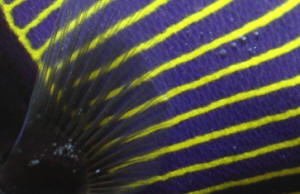 |
|
Treatment Options for Juvenile Emperor with Ich --
03/22/09
Hello WWM Crew,
<Scott>
Thanks you for your outstanding website. With the help in no
small part of your collective advice, I have managed to develop a
135 gallon SPS system which is thriving in a way I could not have
imagined when I began this venture about two and a half years
ago.
<Ahh, congratulations>
If nothing else, I hope this message is a testimonial to other
readers about the value of the quarantine tank.
<Ohh>
I also hope that get some of your experienced advice in
connection with a juvenile emperor angelfish that I acquired last
week. He is a bit small (about 1-1/4 inch nose to tail) but
exceptionally energetic and curious. He also demonstrated a very
good appetite at the LFS store. I purchased him and introduced
him to his temporary home; a 20 gallon OT with "mature"
sponge filter, heater and a couple of power heads.
Unfortunately, after a day or two in quarantine, he started
showing signs of Ich. Referring to the attached photo, you will
likely see the tell-tale spot on his pectoral fin, as well as a
couple tiny spots on his caudal and anal fin.
<I see this>
My first response was to begin to lower the salinity of the tank
and monitor the progression of the parasite and host (i.e. see if
the fish can fight off the Ich with its own natural defenses as
he continues to gain strength in QT). I am also wiping down the
floor/walls of the QT and replacing about four gallons of make-up
water (taking "diluted" water from the main display) on
a daily basis.
<Good>
The salinity is now down to 22 ppt
<Mmm, needs to be quite lower for hyposalinity to be of use
here>
and emperor is showing no signs of distress and maintains his
voracious appetite. But there is also no evidence of any
significant reduction at the affected areas.
<Also good>
I have done lots of research on the subject of Ich and believe
that early and decisive action is very important, so I am
presently considering two treatment options. The first is to
continue the water change and hypo salinity regimen (taking
salinity down to 15-16 ppt for the prescribed duration). Assuming
I can get to the point where there are no longer any visible
spots attached fish, I would do a 100% water change (again, using
diluted water from the main display) and completely wash down the
interior of the QT.
The second option would be treatment with SeaChem Cupramine, but
given the "tender age" of this juvenile emperor, I am
concerned about the toxicity affects over the (hopefully long)
lifetime of this particular fish.
I realize that it is up to the individual aquarist to take
responsibility and implement the appropriate treatment option,
but I would very much appreciate hearing the thoughts of folks
with your collective experience.
Would you follow one (or both) of the treatments outlined above,
or possibly something else altogether?
<Due to the factors you mention, I would go with the first
option>
Thanks in advance.
Scott
<Welcome. Bob Fenner>
|
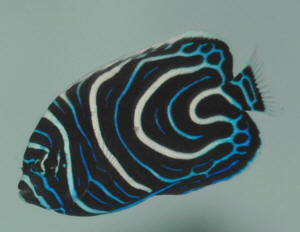 |
|
Need help with lesions on emperor angel
2/18/09 Hello, crew: <Steve> This will be a long
email but I want to give you full info of my tank, inhabitants,
and diet. I have a 600 gallon tank with approx. 150 g sump tank
that contains 650 lbs of live rock and the following livestock:
5" juvenile emperor angel 8" queen angel 6"
miniatus grouper 8" panther grouper 9" Volitans lion
5" porcupine puffer 12" Naso tang 6" powder blue
tang 7" Lunare wrasse 6" harlequin wrasse 13"
snowflake eel 5" blue cheek trigger 5" niger trigger
6" pink tail trigger very large red hermit crab (none of the
fish even try anything with him) no other inverts I feed the fish
quite a varied diet as follows: twice a day I feed a varied combo
of Nori alga, angel formula with sponge frozen cube food, life
line frozen cube with Spirulina, mysis shrimp, prime flake food,
spectrum pellets, Dainichi marine and veggie pellets. I mix and
match all these foods during each feeding so I don't
overfeed. I make sure the amount given at each feeding is fully
consumed within 4-5 min. Every M, W, F, I feed meaty foods
consisting of squid, krill, clam, scallops, and silversides. I
don't just drop the meaty foods in, but rather try to focus
on getting them to the groupers, lion, and puffer. I feed the eel
and hermit one piece each with tongs M, W, and F. The wrasses and
triggers always get some too as they are so fast. I don't
feed any live foods or freeze dried foods. I soak the foods in
Zoecon (soon I will try Selcon as I have some on order) and Kent
marine Vit C. The water parameters are as follows: nitrate 20-30
ppm, nitrite undetectable, pH 8-8.4, temp 76, SG 1.021-1.022,
<Too low...> calcium 420 ppm. <And Mg?> I do run a
carbon filtration system (uncertain of exact size/model), UV
filter, and ozonizer with orb controller that reads out 380-430
(generally reads about 400). I don't add any iodide or
calcium or magnesium specifically to the water. I don't know
exact skimmer make but there are two and each is rated for 600
gallons. Don't know exact watt of lighting but is a
combination of actinic and VHO bulbs set up to give very nice
visibility. No chiller, the water remains at 76 F by itself with
two heaters. Tank was set up about 1 year ago and fish have been
in it for about 10 months. All fish (including emperor angel-see
below) have very healthy appetites and body mass. I have not
found one type of food that every single fish in there will not
go crazy for during feeding. My groupers go nuts over alga and
sponges, and don't spit it out either. The queen angel
occasionally chases the emperor and Naso for maybe 1-2 seconds
and then forgets about them. The Naso seems to ignore this. The
emperor moves away and then immediately continues doing what he
was doing when the queen loses interest. This has never resulted
in a fin damage or body damage that I have seen. Have had no
disease outbreaks thus far (see below comments). All the fish
seem to get along well and appear to be acting completely normal.
The tank gets a 20% water change every 2-3 weeks. Now that you
have the info, here is my main question: I need help figuring out
what is affecting my emperor angel. I included some pics for you
to see. I figure it is HLLE vs. hole in the head, <Yes...
neuromast destruction...> but can't tell which one. The
lesions are very symmetric over his face and around his mouth;
and they started about 4 months ago, gradually. You really
can't tell one side of his face from the other (lesions are
very symmetric). Also, you will see the lesions going up his gill
margins. As you can see, he is in the process of going toward
adult coloration. Not sure if his pale looking face is just part
of that change too, but it seems almost translucent to me, rather
than a healthy white of the adult (his face is normally more pale
and white than shown on the pics). And the pics may not show it,
but I can almost imagine a slight red tinge around his mouth area
(which I have read is a dietary deficiency issue). The lesions
look like deep pitted acne scars and he has one or two perfectly
round "holes" near his eyes. Again, all very symmetric.
Absolutely no lesions along his body or lateral line area. Over
the last couple of weeks, I think I am noticing two extremely
tiny (1-2 mm size) holes under the chin area of the queen angel
now. These too are symmetric (one on each side of midline) They
are so tiny, however, that I am not sure that they aren't
just a normal marking or something. The queen has beautiful and
full perfect fins and adult coloration otherwise. None of the
other fish show any detectable variances off of their normal
coloration/markings, etc from the wild. All (including the
angels) have perfect fins and clear eyes. I have been adding some
Hikari Metro+ to some of the frozen cube food in 3 day treatment
cycles. I have done this for 2 three day cycles. I am just not
sure what else to do or how long it should take to see some
improvement. This is all a little tricky because the angel's
face is white as an adult so I don't know how much of this is
normal coloration change. Even though I suspect most if not all
of this is HLLE or hole in head. I am kinda at my wits end. I
thought I would be able to take care of this angelfish in this
system by supplying appropriate diet, etc. I guess I may fall in
with all the other aquarists in that I should not try to keep an
angel. I just don't know what else to do here. Thanks for any
advice, Steve <Does seem unusual... given the foods you list,
the use of Zoecon... to have such a pronounced nutritional
deficiency syndrome here... Do you have another system you could
move this Angel to? Otherwise... perhaps the Selcon will help...
I would supplement Iodide-ate maybe weekly with water changes...
And possibly add "Miracle Mud" to your sump, culture a
Red Algae there... Bob Fenner>
|
 |
| Re: need help with lesions on emperor
angel 2/18/09 Bob, <Steve> Thank you for the quick
response on such a lengthy email question and description. I will
try what you suggested. I also will try some Hikari A and S marine
pellets just in case. <Worthwhile> Regarding the SG, I
thought having it a little low would help with Cryptocaryon, etc.
<Does, but... the trade off in added stress can be a bad
choice... Pomacanthus imperators from certain areas in particular
are very susceptible to neuromast destruction syndromes> I saw
the article on your website about a year ago of the guy with 20-30
angels, triggers and tangs in a 240 gallon aquarium that keeps the
SG somewhere below 1.015 for that reason (no corals). <Yes...
and is cheaper in terms of salt mix cost, and you can much higher
stocking densities due to higher dissolved oxygen, and...> I
will, of course, increase the SG if you feel that would be best.
<I do... along with the "Mud", algal culture... these
will importantly impart desirous chemicals, physical properties to
the water that can reverse the damage here> I just thought it
would not be as crucial for the fish. I was not sure if it could
hurt the hermit crab. I will try to let you know if the condition
of the angel improves by this summer. <Thank you> I do have
one other question: my blue cheek trigger looks and acts great, and
eats well. He is fat, but he is almost one year old and just
doesn't seem to be growing at the rate of the other fish. Is
that normal for that species? <Mmm, no... could be other factors
at play. Please see my resp. in the Daily FAQs today re someone
with a stunted Porcupine Puffer. BobF> Steve Bob, <Steve>
Sorry, but I forgot 2 other questions regarding this emperor with
neuromast destruction: 1. Should I keep trying the metro+ addition
to the food in 3 day cycles, or is this condition completely
different from what that medication is designed for? <None...
see WWM re the use of Metronidazole/Flagyl... is very dangerous to
continually, repetitively administer...> 2. Could lighting in
the tank have any play in this? <Mmm, none as far as I'm
aware... unless you give more credence to the possibility of stray
voltage being an a priori cause of HLLE... but, the other fish
livestock don't show symptoms as you note. Ohhh! I see the
"angle" below...> I ask because I started to reduce
the amount of time that the lights were on to reduce some alga
growth on the live rock and glass. The fish would graze on the
alga, but they could not keep up and every month I would scrape
quite a bit off the rock when cleaning. I decided to manually turn
on the lights only during feedings for about an hour each time and
whenever people were over and wanted to see the tank. This resulted
in the lights being on for 2-4 hours per day rather than the
previous 8 or more hours per day (on a timer). This condition
started to occur somewhere around the time I started to reduce the
time the lights are turned on, so I just didn't know if that
could be a factor. I know fish will do better with actual sunlight,
but this is VHO and actinic bulbs. I just thought that with no
coral in there it would be ok to reduce the lighting to feed time
only, etc. The alga has diminished a lot and the rock looks more
natural, but there is still plenty of surface alga on the rocks and
the angels and tangs do graze on it. Thank you again, Steve
<Good point... and... see WWM re lighting periodicity... better
to have on... a timer... regular... and to have the algae to graze
on as you state. B> |
HLLE, Pomacanthus, reading 10/22/08 Hi
Folks, <Matt> I will try to make this short and sweet. You guys
are terrific. <Danke> I have a 225 gallon FOWLER. The tank is
about 5 years old and the tank has no traces of Nitrate (5ppm or lower)
and all other levels are good. I have raised a Queen Angel, Imperator,
and Navarchus since they were babies. They get along well and are
healthy. I had to move the tank and since it has stressed out my
Imperator. He seems to have started to develop "hole in
head". <Not uncommon> It is not bad yet and he is active and
feeding well. Not sure how this happened. <?> I am wondering if I
should start to look at new filtration. The tank has excellent water
flow, an excellent skimmer, bio balls in the sump (I know you guys
don't like this) and a U/V. Is it time after 5 years to get rid of
the bio balls? <I would> Could I use my current sump to maybe do
a eco system mud filter? <A possibility> I would really
appreciate some feedback. Thanks a ton, Matt <Sure... read here:
http://wetwebmedia.com/HLLESWCure.htm and the linked files above. Bob
Fenner>
 |
Angelfishes for Marine
Aquariums
Diversity, Selection & Care
New eBook on Amazon: Available
here
New Print Book on Create Space: Available
here
by Robert
(Bob) Fenner
|
|
|

